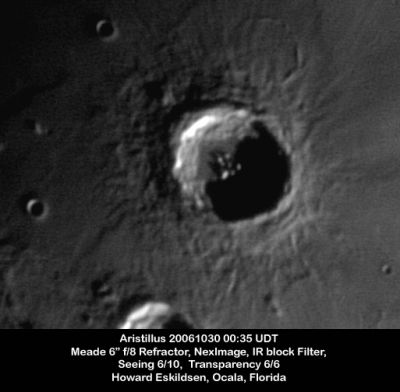Aristillus
Contents
[hide]Aristillus
|
Lat: 33.9°N, Long: 1.2°E, Diam: 55 km, Depth: 3.3 km, Rükl: 12, Eratosthenian |

Howard Eskildsen
- The most interesting fact about the pronounced crater Aristillus is the unnamed ghost-crater immediately north of it, interesting because it is a very easy telescopic target during local sunrise or sunset circumstances! Nobody of the I.A.U. (International Astronomical Union) seems to have thought of it to give that easy-to-observe ghost crater an official name or letter designation. Well, I call it the Ghost of Aristillus, or rather the Unsung Ghost of Aristillus. - DannyCaes Feb 19, 2017
- Two dark rays at the inner and outer slopes of the northeastern part of Aristillus, see LROC ACT-REACT Quick Map; shortlink http://bit.ly/2mnNg6K (are these dark rays observable through powerful telescopes?).
Images
LPOD Photo Gallery Lunar Orbiter Images Apollo Images
Maps
(LAC zone 25C4) LAC map Geologic map
Description
Description: Elger
(IAU Directions) ARISTILLUS.--A larger and much more elaborate ring-plain, 34 miles in diameter, N. of Autolycus. Its complex wall, with its terraces within, and its buttresses, radiating spurs, and gullies without, forms a grand telescopic object under a low sun on a good night. It rises on the west 11,000 feet above the Mare, and is about 2000 feet lower on the E., while the interior is depressed some 3,000 feet. Its massive central mountain, surmounted by many peaks, occupies a considerable area on the floor, and exhibits a digitated outline at the base. On the S. and E. a number of deep valleys radiate from the foot of the border, some of them extending nearly as far as Autolycus. Shallower but more numerous and regular features of the same class radiate towards the N.W. from the foot of the opposite wall. On the N.E. are several curved ridges, all trending towards Theaetetus. On the S.W. the surface is trenched by a number of crossed gullies, well seen when the W. wall is on the morning terminator. Just beyond the N. glacis is a large irregular dusky enclosure with a central mound, and another smaller low ring adjoining it on the S.W. The visibility of these objects is very ephemeral, as they disappear soon after sunrise. Aristillus is also the centre of a bright ray system.
Description: Wikipedia
Additional Information
- Depth data from Kurt Fisher database
- Pike, 1976: 3.3 km
- Westfall, 2000: 3.3 km
- Viscardy, 1985: 3.65 km
- Cherrington, 1969: 3.2 km
- Originally mapped as Copernican because of rays, but these are compositional rays (highlands material) that have reached full optical maturity and thus crater is older than Copernicus and is Eratosthenian age. Hawke et al Composition and origin of Copernican Rays… Mappers Conference 2005??
- Central peak composition: GNTA2 & AN (Tompkins & Pieters, 1999)
- Included in ALPO list of bright ray craters.
- Included in ALPO list of banded craters
- West rim slope 48° (Pohn, 1963)
- TSI = 35, CPI = 20, FI = 20; MI =75 Smith and Sanchez, 1973
- W. H. Pickering regarded the dark streaks that can be seen draped over the eastern rim of Aristillus at certain sun angles as canals in which he saw seasonal changes (although the moon is dry as cork, it somehow reminds me the streaks of salty water discovered on Mars - DannyCaes Oct 11, 2015).
Nomenclature
- Named for Aristillus (fl. ca. 280 BC), a Greek astronomer who created the first star catalogue in approximately 300 BC, with the help of Timocharis.
- Aristillus-ghost or Ghost of Aristillus (nicknames from D.Caes for the Autolycus-sized ghost crater immediately north of Aristillus).
LPOD Articles
A Ribbon of Darkness 1.5 Billion Years of History A and A
Bibliography